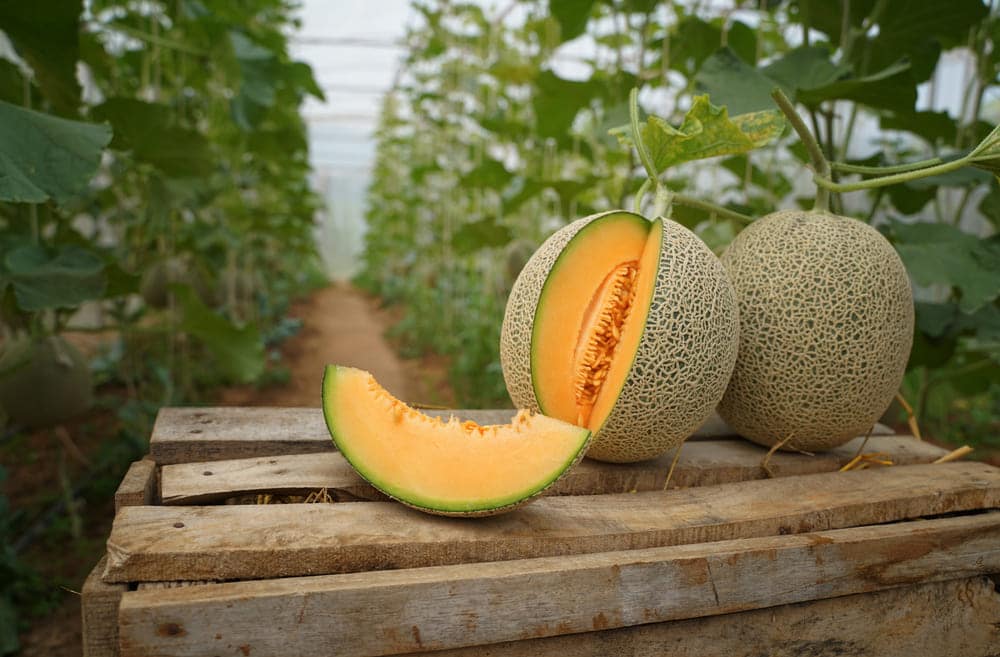Can Dogs Eat Cantaloupe? Yes, But in Moderation
Cantaloupe is a safe and even healthy treat for dogs in moderation. It offers benefits:
- Vitamins: Rich in vitamins A and C, which support the immune system and vision.
- Hydration: High in water content, making it a refreshing and hydrating snack.
- Fiber: Supports healthy digestion and can help regulate bowel movements.
Important Considerations
- Too Much is Bad: Overeating cantaloupe can lead to digestive issues like diarrhoea and stomach upset due to its sugar content.
- Treat, Not Meal: Cantaloupe should only make up a small portion (around 10%) of your dog’s daily food intake.
- Remove Seeds and Rind: These parts pose a choking hazard and can cause digestive problems.
Unsafe Melon Parts
- Rind: Avoid feeding the rind as it is tough and can cause choking or digestive blockages.
- Melon Skin in General: The skin of other melons should also be avoided for the same reasons.
Symptoms of Cantaloupe Overconsumption
Watch out for these signs if your dog has eaten too much cantaloupe:
- Diarrhea
- Vomiting
- Lethargy
- Stomach pain
How to Feed Cantaloupe Safely
- Choose Ripe Cantaloupe: It is sweeter and easier for your dog to digest.
- Remove Rind and Seeds: These are not safe for consumption.
- Cut into Bite-Sized Pieces: Prevent choking hazards.
- Moderation is Key: Stick to a small amount as a treat.
Key Takeaways
- Cantaloupe is a healthy occasional treat for dogs when served safely.
- It offers vitamins, hydration, and fibre, but keep portions small to avoid digestive upset.
- Only feed the fleshy part of the melon, never the rind or seeds.
- Consult your veterinarian if you have any concerns about feeding cantaloupe to your dog, especially if they have any health conditions.
Do dogs like the taste of cantaloupe?
As per the research done on the dog’s preference in eating cantaloupe, it can be said that most dogs do not like to eat cantaloupe mainly because of the soft and juicy texture of the piece of melon.
Whereas in some cases, the dogs might also enjoy eating cantaloupe due to its sweet taste. Therefore, based on this, it can be said that dog cantaloupe preference depends on them; it depends on the pet when they will enjoy eating this healthy diet or behave offended after getting this to eat.
What are the benefits of cantaloupe for the canine?
Dog owners need to know about the benefits of feeding cantaloupe to the canine, as it will help them to decide why this should be included in the dog’s diet.
It will also help dog owners properly decide the amount of cantaloupe per day for the canine according to its nutritional requirements. Below are the factors that prove the beneficial nature of cantaloupe to the canines.
Beta carotene: The presence of this dietary fibre named beta carotene in the cantaloupe makes it a worthy treat for the canine.
The beta carotene of the cantaloupe is good for the digestive health of the canine; once it gets into the stomach, it gets converted into vitamin A, which further acts as a powerful antioxidant and prevents the canine from the free radicals that attack its body and promotes better functioning of the dog’s immune system.
Folate: The presence of folate in this dog cantaloupe makes this a healthy option for the dogs to eat. It is most important for the proper metabolic functions of the body, like DNA synthesis and red blood cell production.
It can even cure issues like stomach upset and promote healthy cell function, hence eventually making cantaloupe a healthy option for the canine.
The high amount of water in it: As compared to other melons, the water concentration in cantaloupe is much higher, which makes it one of the best alternatives for water. Inducing this even during the snack time of the canine can keep it hydrated all the time during the hot summer day and can prevent the pet from diseases like dehydration.
Can dogs eat cantaloupe?
Yes, the consumption of cantaloupe is safe for the canine in moderation. However, this melon should be strictly used as an occasional treat as more consumption can be toxic to dogs.
As compared to other fruits, the chances of health problems are quite low in this melon. Thus, its consumption is considered safe, and dogs can eat the melon frequently by making alternate gaps.
Overweight dogs need to maintain a quite longer frequency than other dogs for healthy digestion. Thus, to keep its consumption safe, the dog’s parents should feed cantaloupe to the canine after having a proper discussion with the vet.
Can dogs eat ripe cantaloupe?
Yes, ripe cantaloupe is best for dogs to eat. This is mainly because the raw ones might be quite sour, and the dogs can get offended.
Thus, due to the sweetness of the cantaloupe, it is suggested that the ripe cantaloupe be fed in moderation to the canine, whereas all the other properties are the same, so there is not much difference regarding the serving procedure.
How much cantaloupe can a dog eat?
Dog owners need to know about the proper dose of cantaloupe per day for the canine according to the dietary fibre present in it.
This is because knowing the proper dose will promote the healthy digestion of the cantaloupe and will help decide if its consumption is going to be safe for the canine or not.
As per the research done on the dog’s digestive system, the consumption of cantaloupe per day for the canine should be approximately equal to ten per cent of the total intake of the canine.
Feeding your dog cantaloupe will not only promote the immune system but will also help to reduce blood clotting due to some injuries if induced in the regular diet of the canine.
Can dogs eat cantaloupe rind?
No, the consumption of cantaloupe rind is not suggested for the canine at all. This is because it can lead to choking hazards, and for diabetic dogs, these dog treats can even be fatal; thus, they need to be strictly avoided.
Cantaloupe rinds can get stuck in the throat of the canine if consumed in large amounts, which can lead to medical emergencies. Thus, the consumption of cantaloupe rinds is prohibited as the choking risks can even lead to the death of the canine in severe cases.
What are the symptoms that dog owners can notice when cantaloupe rind poisoning is present in canines?
As we have already mentioned above, the consumption of cantaloupe rind can lead to choking hazards; there are some symptoms the owner can notice in the behaviours of the canine to detect if its consumption is toxic or not.
The symptoms to notice are gastrointestinal distress, vomiting, diarrhoea, and lethargy. This behaviour usually gets noticeable after a few hours of consumption.
It is strictly suggested that dog owners go for an abrupt vet visit once they detect such symptoms to avoid choking. The owner can also induce vomiting.
Can dogs eat melon skin?
No, the consumption of melon skin is not at all suggested for the canine. This is mainly because its consumption can lead to different types of stomach disorders, which can be difficult for dog owners to handle and can even lead to disastrous conditions.
Melon skin can cause gastrointestinal distress and digestive upset and even impact the digestive tract of the canine; thus, it should be strictly kept away from the dog’s food.
What happens when the dog eats too much cantaloupe?
When the canine eats too much cantaloupe, it can lead to different types of diseases for the canine, which can even be fatal to its health. The diseases detected in a canine when it eats too much cantaloupe are mentioned below.
Diarrhoea: Overfeeding of the cantaloupe often leads to interruption between the smoothly regulated enzymatic reactions in the stomach, which increases the acidic level of the stomach and leads to diarrhoea.
Vomiting: Indigestion due to overeating the cantaloupe leads to vomiting, as the dog is not able to properly digest the fruit due to its large amount, which causes the canine to split up the food consumed.
Lethargy: The dog even faces lethargy when eating the cantaloupe in an over amount because overconsumption of the fruit lowers the metabolic rates of the canine’s body, which also affects the bowel movements of the canine. This leads to the lethargic behaviour of the canine.
Stomach pain: Just like humans, a dog also gets to suffer from stomach pain when it eats something more than required. This stomach pain is mainly caused by the proper fulfilment of the stomach with the same amount of nutrients.
Can a dog eat cantaloupe ice cream?
Most of the time, the parents used to misunderstand that feeding the cantaloupe-flavoured ice cream would be safe for their canine’s health because cantaloupe is safe for the canine. However, the fact here is that the ice cream is prepared with the extract of cantaloupe.
A lot of other ingredients like flavoured sugar, cream, milk, and artificial sweetening agents are used in the preparation of this ice cream, which can be disastrous for the canine’s health.
It can lead to many types of health issues, such as canine-like toothache, increased blood pressure, and many others. Thus, the consumption of cantaloupe ice cream is prohibited for the canines.
How much cantaloupe can be too much for the canine?
As we have already mentioned above, the intake of cantaloupe should be ten per cent of the dog’s total consumption per day. However, in some cases, the proper dose may differ from those mentioned above as the nutrient requirement of the canine may differ from breed to breed and also depending on their size.
Thus, to decide the appropriate dose of cantaloupe consumption as per the nutritional deficiency of the canine, the owners are suggested to visit a vet and take a properly detailed checkup of the canine to detect the nutritional deficiency and to decide the dose accordingly.
How to feed cantaloupe to the canine?
If the dog owner is all set to feed the canine cantaloupe, then the owner should strictly remove the rinds and the skin first to make it choking hazards-free, then wash it thoroughly and cut it into bite-size pieces for proper swallowing.


